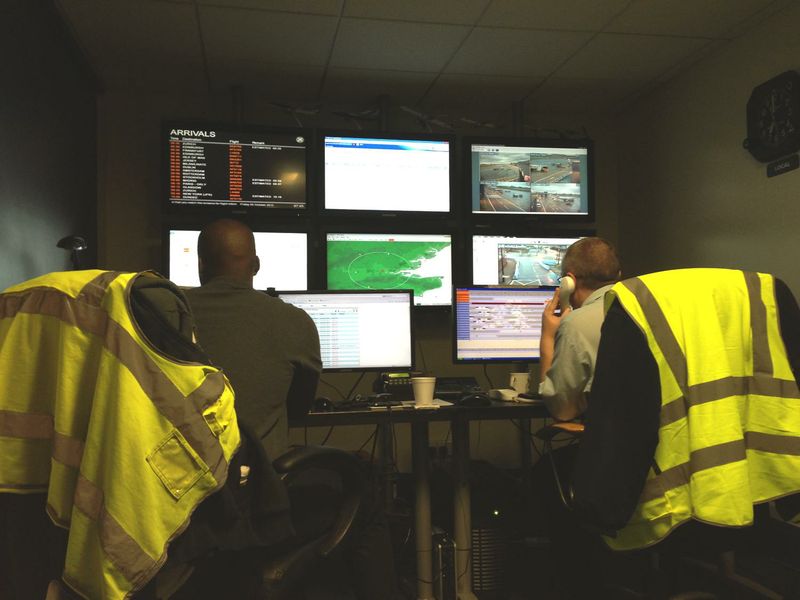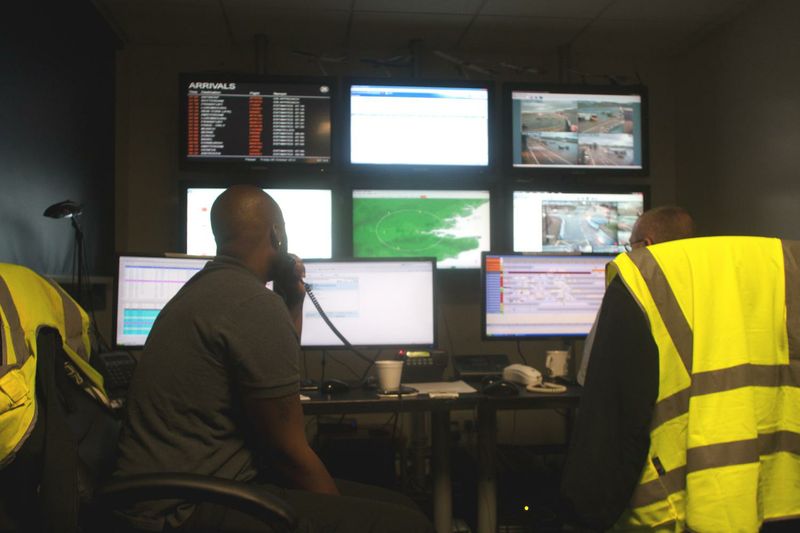Behind the Scenes: London City Airport – Ramp Control: An art in planning, control and management.
- Behind the Scenes: London City Airport: The Introduction
- Peak rush to London, aLoft ExCeL
- Morning time at LCY – Inspecting runway lights
- Ramp Control and Operations (THIS SECTION)
- At the JetCentre
- Ramp Walk 1
- Ramp Walk 2
- From the Tower
- Watery Inspections with the Fire Service
- Leaving London and Final Thoughts
After the inspection vehicle had dropped my escort and myself outside JetCentre, we headed up to Ramp control to shadow their operations for a while.
Ramp control as the name suggests controls activity on the ramp and apron of the airport, warning handling crews what time planes are due in, and where. And no matter the time of the day, it’s a busy place with lots of people managing a small airport.
Today, two people were managing the morning arrivals and morning departures rush, with another two handing reporting and planning.
Conversing in a quiet moment
Answering a query on a plane that is staying a bit longer than intended
Talking to the ramp.
It’s the place that controls the buses and where the planes park.
So… a rather important spot.
The screens are rather interesting – but for a lot of us – the one with a map of the South East of England is the one that holds most interest. If you look at the screen carefully, you’ll see a ring drawn around it. Depending on the runway and how it is used it’s 10 minutes to the airport if on a river approach, 15 if coming from the rest of UK.
And in those 10 minutes, ramp workers need to be notified, and stands need to be confirmed – with confirmation at 10 minutes normally. Of course if there is a major rush, its a case of get the plane down and then get it to a stand.
There was some issues in the past of parking the bigger planes at the airport – especially since the Embraer 170/190’s are becoming very popular at the airport over the older AvroRJ/BAe-146 series. Thankfully the stands have been re-configured so that all but two stands can now cope with any regional aircraft (The British Airways A318’s that have to live at the apron near Gate 23/24).
Of course, planes don’t exactly always obey timings and irregular operations happen – that’s when this team re-plan and identify the changes that need to be made as needed.
There is a lot of dual working – and sometimes three person working when extra busy to handle radio and telephone communications.
Handling of arrivals, departures and what work needs to be done is managed from a constantly updated planning tool – and it allows for long range planning for 6 hours and beyond. However, there are things that come into play that can cause issues – for example the day I was there a NOTAM (Notice To Airmen) was issued that Strong winds were expected in the LCY area from 08:00 – this impacts on landings – and possible go-arounds too.
Other things that can impact are snow, Fog (an issue London City suffers due to it being slap bang in the middle of the Royal Albert Docks, and the River Thames to the side of it) and of course – bird strikes. Should systems go down (dread the thought), the operation can be split with staff pitching up at operations, whilst others are working ramp control at ops and working over radios till systems can be brought back up.
It’s a tough operation – but the team mange it with ease.
The ramp teams work in groups of 8-9 depending on the loads and the shifts to meet the deadlines that airline managers put on them to turn planes around – and as a lot of aircraft “pit stop” only at LCY, they need to make sure the right balance of people are assigned. For example:
- For an AvroRJ/BAe146, or a TurboProp 2 people can manage the load/unload and prep of the aircraft
- For an ERJ, becaue of the extra load of passengers and cargo they can hold, three people are needed.
- Lufthansa/Swiss CRJ’s have requirements where to place bags in the hold
The number of people also depends on the load and what cargo is handled – so constant replanning is needed to ensure a top quality service. It also allows the airport to bring in staff as needed in a controlled manner as opposed to just over-hiring people – allowing costs to be controlled.
It also allows the right people to be on-site too – so for example, more staff can be pulled in on the busy mornings on Monday and Tuesday, whilst reducing the need for people that are needed for Saturday morning.
That’s important because the costs that are spent at an airport have to be paid by an airline – which eventually goes into the price of the ticket we pay to fly.
There are challenges to the posts that are run by Ramp control – for example the constant repeating of information and sometimes the ramp workers wondering why things are done a certain way. Ramp Control are planning more “experience days” to share the knowledge and information that they do with the ramp workers – and show them the impact the decision made in control have on the ground, with the impact those decisions have.
And what an interesting challenge they have there, squeezing in the departures and arrivals, getting bags loaded and unloaded, fuelling planes, ensuring stands are available, if buses are needed and where to make them accessible.
Next up: A walk around At the JetCentre
Disclosure: London City Airport kindly supplied a hotel room at aLoft ExCeL to me to assist in this visit. Some details and factual information has been provided by London City Airport Corporate Communications Department.
All opinions expressed within this trip are my own, represent my own personal thoughts and my observations during the visit.
You can find out more about London City Airport at http://www.londoncityairport.com/


